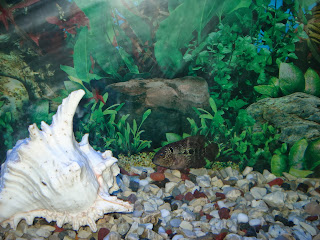Parrot Cichlid

Blood Red Parrot Cichlid, a Hybrid Cichlid The Blood Red Parrot cichlid is an odd ball man made Hybrid that has stirred quite a bit of controversy in the fish world but has gained a huge popularity with many. Whether you approve of hybrid fish or not, these wonderful Blood Red Parrot Cichlids are here to stay. They are very compatable for a community tank as they are peaceful, curious and they interact well with their fish keepers once they get to know you. Blood Red Parrot fish should not be confused with the true Parrot Cichlid (Hoplarchus Psittacus) or the Salt Water Parrot (Callyodon Fasciatus). When choosing Blood Red Parrot fish you will notice that the baby Parrots are very dark with stripes. As they start to grow they change color quickly from dark to a mottled black and orange to a true solid Orange. This happens very quickly within the first four months. Parrot Cichlid History First created in Tiawan in the 1980's the Blood Red Parrot Cichlid ...




